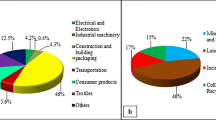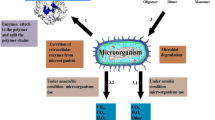Abstract
In the case of plastics containing brominated flame retardants, various brominated organic compounds, including polybrominated dibenzodioxins and dibenzofurans, are yielded when they are degraded. In order to reduce the hazard that might be generated during after-live treatment, the behaviour of flame retarded high-impact polystyrene containing decabromo diphenylether and antimony oxide (Sb2O3), was investigated using several heating programs. It was found that the separation of the thermal process into two steps divided at 330 °C makes it possible to obtain an oil fraction rich in brominated compounds at low temperatures and an oil fraction depleted in brominated compounds at high temperatures. The low temperature oil contained a high concentration of SbBr3 and dibromodibenzofurans. Various brominated compounds with a low volatility and 1-bromo-1-phenylethane from the reaction of HBr with styrene were among the substances in the high temperature oil. The concentration of brominated compounds was reduced from 6 wt% for degradation in a single step to below 1 wt% in the high temperature oil in the two step process.




Similar content being viewed by others
References
Grause G, Buekens A, Sakata Y, Okuwaki A, Yoshioka T (2011) Feedstock recycling of waste polymeric material. J Mater Cycles Waste Manage 13:265–282
Luijk R, Govers HAJ, Nelissen L (1992) Formation of polybrominated dibenzofurans during extrusion of high-impact polystyrene/decabromodiphenyl ether/antimony(III) oxide. Environ Sci Technol 26:2191–2198
Luijk R, Wever H, Olie K, Govers HAJ, Boon JJ (1991) The influence of the polymer matrix on the formation of polybrominated dibenzo-p-dioxins (PBDDs) and polybrominated dibenzofurans (PBDFs). Chemosphere 23:1173–1183
Vasile C, Brebu MA, Karayildirim T, Yanik J, Darie H (2006) Feedstock recycling from plastic and thermoset fractions of used computers (I): pyrolysis. J Mater Cycles Waste Manage 8:99–108
Bhaskar T, Mitan N, Onwudili J, Muto A, Williams P, Sakata Y (2010) Effect of polyethylene terephthalate (PET) on the pyrolysis of brominated flame retardant-containing high-impact polystyrene (HIPS-Br). J Mater Cycles Waste Manage 12:332–340
Peng S, Chen L, Li L, Xie M, Huang H, Liu X (2010) Debromination of flame-retarded TV housing plastic waste. J Mater Cycles Waste Manage 12:103–107
Kulkarni PS, Crespo JG, Afonso CAM (2008) Dioxins sources and current remediation technologies—a review. Environ Int 34:139–153
Tange L, Drohmann D (2005) Waste electrical and electronic equipment plastics with brominated flame retardants—from legislation to separate treatment—thermal processes. Polym Degrad Stab 88:35–40
Dufton PW (2003) Flame retardants for plastics market report. Rapra Technology Ltd., Shrewsbury
Riess M, Ernst T, Popp R, Müller B, Thoma H, Vierle O, Wolf M, van Eldik R (2000) Analysis of flame retarded polymers and recycling materials. Chemosphere 40:937–941
Jakab E, Uddin MA, Bhaskar T, Sakata Y (2003) Thermal decomposition of flame-retarded high-impact polystyrene. J Anal Appl Pyrolysis 68–69:83–99
Grause G, Karakita D, Ishibashi J, Kameda T, Bhaskar T, Yoshioka T (2011) TG-MS investigation of brominated products from the degradation of brominated flame retardants in high-impact polystyrene. Chemosphere 85:368–373
Blazsó M, Jakab E (1999) Effect of metals, metal oxides, and carboxylates on the thermal decomposition processes of poly (vinyl chloride). J Anal Appl Pyrolysis 49:125–143
Bockhorn H, Hornung A, Hornung U, Jakobströer P, Kraus M (1999) Dehydrochlorination of plastic mixtures. J Anal Appl Pyrolysis 49:97–106
Bhaskar T, Matsui T, Kaneko J, Uddin MA, Muto A, Sakata Y (2002) Novel calcium based sorbent (Ca–C) for the dehalogenation (Br, Cl) process during halogenated mixed plastic (PP/PE/PS/PVC and HIPS-Br) pyrolysis. Green Chem 4:372–375
Bhaskar T, Uddin MA, Murai K, Kaneko J, Hamano K, Kusaba T, Muto A, Sakata Y (2003) Comparison of thermal degradation products from real municipal waste plastic and model mixed plastics. J Anal Appl Pyrolysis 70:579–587
Murata K, Hirano Y, Sakata Y, Uddin MA (2002) Basic study on a continuous flow reactor for thermal degradation of polymers. J Anal Appl Pyrolysis 65:71–90
Onwudili JA, Insura N, Williams PT (2009) Composition of products from the pyrolysis of polyethylene and polystyrene in a closed batch reactor: Effects of temperature and residence time. J Anal Appl Pyrolysis 86:293–303
Uemichi Y, Makino Y, Kanazuka T (1989) Degradation of polyethylene to aromatic hydrocarbons over metal-supported activated carbon catalysts. J Anal Appl Pyrolysis 14:331–344
Serrano DP, Aguado J, Escola JM, Garagorri E (2003) Performance of a continuous screw kiln reactor for the thermal and catalytic conversion of polyethylene-lubricating oil base mixtures. Appl Catal B 44:95–105
Grause G, Ishibashi J, Kameda T, Bhaskar T, Yoshioka T (2010) Kinetic studies of the decomposition of flame retardant containing high-impact polystyrene. Polym Degrad Stab 95:1129–1137
Bhaskar T, Matsui T, Uddin MA, Kaneko J, Muto A, Sakata Y (2003) Effect of Sb2O3 in brominated heating impact polystyrene (HIPS-Br) on thermal degradation and debromination by iron oxide carbon composite catalyst (Fe–C). Appl Catal B 43:229–241
Hall WJ, Williams PT (2006) Fast pyrolysis of halogenated plastics recovered from waste computers. Energ Fuel 20:1536–1549
Blazsó M, Czégény Z, Csoma C (2002) Pyrolysis and debromination of flame retarded polymers of electronic scrap studied by analytical pyrolysis. J Anal Appl Pyrolysis 64:249–261
Vasile C, Brebu MA, Karayildirim T, Yanik J, Darie H (2007) Feedstock recycling from plastics and thermosets fractions of used computers. II. Pyrolysis oil upgrading. Fuel 86:477–485
Imai T, Hamm S, Rothenbacher KP (2002) Comparison of the recyclability of flame-retarded plastics. Environ Sci Technol 37:652–656
Antos K, Sedlár J (2005) Influence of brominated flame retardant thermal decomposition products on HALS. Polym Degrad Stab 90:188–194
Bhaskar T, Hall WJ, Mitan NMM, Muto A, Williams PT, Sakata Y (2007) Controlled pyrolysis of polyethylene/polypropylene/polystyrene mixed plastics with high impact polystyrene containing flame retardant: effect of decabromo diphenylethane (DDE). Polym Degrad Stab 92:211–221
Bhaskar T, Negoro R, Muto A, Sakata Y (2006) Prevention of chlorinated hydrocarbons formation during pyrolysis of PVC or PVDC mixed plastics. Green Chem 8:697–700
Jorgensen AD, Picel KC, Stamoudis VC (1990) Prediction of gas chromatography flame ionization detector response factors from molecular structures. Anal Chem 62:683–689
Achilias DS, Kanellopoulou I, Megalokonomos P, Antonakou E, Lappas AA (2007) Chemical recycling of polystyrene by pyrolysis: potential use of the liquid product for the reproduction of polymer. Macromol Mater Eng 292:923–934
Acknowledgments
This research was partially supported by the Japanese Ministry of Education, Science, Sports, and Culture, Grand-in-Aid for Scientific Research (A), 30241532, 2009.
Author information
Authors and Affiliations
Corresponding author
Rights and permissions
About this article
Cite this article
Grause, G., Karakita, D., Kameda, T. et al. Effect of heating rate on the pyrolysis of high-impact polystyrene containing brominated flame retardants: fate of brominated flame retardants. J Mater Cycles Waste Manag 14, 259–265 (2012). https://doi.org/10.1007/s10163-012-0067-8
Received:
Accepted:
Published:
Issue Date:
DOI: https://doi.org/10.1007/s10163-012-0067-8




